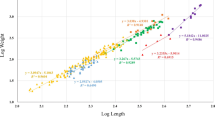Abstract
Length-weight (LWR), length-length (LLR) relationships and relative condition factor (Kn) were determined for the conchfish Astrapogon stellatus (Cope, 1867) in the Mesoamerican Reef System, Mexico. A total of 26 specimens were collected between 2016 and 2018. The LWR for A. stellatus was W = 0.0159*TL2.972. LLR was highly significant (r2 = 0.989) and the range of Kn was 0.85–1.26. These findings have not been previously reported in the literature, such data is valuable for understanding population dynamics for this a poorly known species that could be within some endangered category.




Similar content being viewed by others
References
Ahamed F, Saha N, Nishat MA, Biswas MK, Sultana M, Khatun MS, Ahmed ZF, Hossain MY, Ohtomi J (2018) Length-weight and length-length relationships of three small indigenous fishes from the Payra River, southern Bangladesh. J Appl Ichthyol 34:777–779. https://doi.org/10.1111/jai.13642
Aucoin S, Himmelman JH (2010) A first report the shrimp Pontonia sp. And other potential symbionts in the mantle cavity of the penshell Pinna carnea in the Dominican Republic Symbiosis 50: 135–141. https://doi.org/10.1007/s13199-010-0050-x
Baldwin CC, Mounts JH, Smith DG, Weigt LA (2009) Genetic identification and color descriptions of early life-history stages of Belizean Phaeoptyx and Astrapogon (Teleostei: Apogonidae) with comments on identification of adult Phaeoptyx. Zootaxa 1–22. https://doi.org/10.11646/zootaxa.2008.1.1
Baumann JH, Ries JB, Rippe JP, Courtney TA, Aichelman HE, Westfield I, Castillo KD (2018). Nearshore corals on the Mesoamerican Barrier Reef System on pace to cease growing as soon as year 2110. BioRxiv 298158. https://doi.org/10.1101/298158
Froese R (2006) Cube law, condition factor and weight-length relationships: history, meta-analysis and recommendations. J Appl Ichthyol 22:241–253. https://doi.org/10.1111/j.1439-0426.2006.00805.x
Froese R and Pauly D (2019) FishBase. World Wide Web Electronic Publication. http://www.fishbase.org. Accessed 01 December 2019
Froese R, Tsikliras AC, Stergiou KI (2011) Editorial note on weight-length relations of fishes. Acta Ichthyol Piscat 41:261–263. https://doi.org/10.3750/AIP2011.41.4.01
Gilmore G and Fraser T (2015) Astrapogon stellatus. The IUCN Red List of Threatened Species 2015: e.T185869A1784179. https://doi.org/10.2305/IUCN.UK.2015-2.RLTS.T185869A1784179.en. (12/ 2019)
Hossain MY, Rahman MM, Ahamed F, Ahmed ZF, Ohtomi J (2014) Length-weight and length-length relationships and form factor of three threatened fishes from the Ganges River (NW Bangladesh). J Appl Ichthyol 30:221–224. https://doi.org/10.1111/jai.12251
Karplus I (2014) Symbiosis in fishes: The biology of interspecific partnerships. Wiley Blackwell, Oxford, UK
Keys AB (1928) The weight-length relation in fishes. Proc Natl Acad Sci U S A 14:922–925
Kimmerer W, Avent SR, Bollens SM, Feyrer F, Grimaldo LF, Moyle PB, Nobriga M, Visintainer T (2005) Variability in Length–weight relationships used to estimate biomass of estuarine fish from survey data. Trans Am Fish Soc 134:481–495. https://doi.org/10.1577/T04-042.1
Le Cren ED (1951) The length-weight relationship and seasonal cycle in gonad weight and condition in the perch (Perca fluviatilis). J Anim Ecol 20:201–219. https://doi.org/10.2307/1540
Livingston RJ (1971) Circadian rhythms in the respiration of eight species of cardinal fishes (Pisces: Apogonidae): comparative analysis and adaptative significance. Mar Biol 9:253–266. https://doi.org/10.1007/BF00351388
Moura RL, Gasparini JL, Sazima I (1999) New records and range extensions of reef fishes in the Western South Atlantic, with comments on reef fish distribution along the Brazilian coast. Revta bras Zool 16:513–530
Plate L (1908) Apogonichthys strombi n.sp., ein symbiotisch lebender Fische von den Bahamas. Zool Anz 33:393–399
Prada MC, Appeldoorn RS, Eijs V, Pérez MM (2017) Regional Queen Conch fisheries management and conservation plan. FAO Fisheries and Aquaculture Technical Paper No. 610. FAO, Rome
Randall JE (1964) Contributions to the biology of the queen conch, Strombus gigas. Bull Mar Sci 14:246–295
Richards WJ (2006) Early Stages of Atlantic Fishes: An identification guide for the Western central north Atlantic. CRC Press, Boca Raton, Florida
Sabido-Itzá MM, Aguilar-Perera A, Medina-Quej A (2016) Length-weight and length-length relations, and relative condition factor of red lionfish, Pterois volitans (Actinopterygii: Scorpaeniformes: Scorpaenidae), from two natural protected areas in the Mexican Caribbean. Acta Ichthyol Piscat 46:279–285. https://doi.org/10.3750/AIP2016.46.4.01
Acknowledgements
The author wishes to express his gratitude to the professors and students of Instituto Tecnologico de Chetumal that helped in the monitoring of the Queen Conch. To the National Commission of Natural Protected Areas (CONANP), Xcalak Reefs National Park, Chinchorro Bank Biosphere Reserve, the local fishermen of the fishing cooperatives, the environmental group “Jovenes por Xcalak” and Francisco Castañeda for helping in editing figures. This project was funded by the CONANP through the Conservation of Endangered Species program.
Availability of Data and Material
The datasets generated during and/or analyzed during the current study are available from the corresponding author on reasonable request.
Funding
This project was funded by the National Commission of Natural Protected Areas (CONANP) through the Conservation of Endangered Species program.
Author information
Authors and Affiliations
Contributions
All authors contributed to the study conception and design. Material preparation, data collection and analysis were performed by all authors.
Corresponding author
Ethics declarations
Conflict of Interest
The authors declare that they do not have any conflict of interest.
Additional information
Publisher’s Note
Springer Nature remains neutral with regard to jurisdictional claims in published maps and institutional affiliations.
Rights and permissions
About this article
Cite this article
Sabido-Itzá, M.M., Hernández-Millán, M.B., Medina-Quej, A. et al. Length-Weight, Length-Length Relationships and Condition of the Conchfish Astrapogon stellatus Cope, 1867 (Teleostei: Apogonidae) in the Mesoamerican Reef System, Mexico. Thalassas 37, 141–145 (2021). https://doi.org/10.1007/s41208-020-00280-2
Received:
Revised:
Accepted:
Published:
Issue Date:
DOI: https://doi.org/10.1007/s41208-020-00280-2



